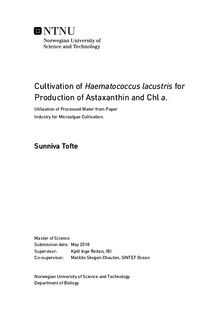Cultivation of Haematococcus lacustris for Production of Astaxanthin and Chl a. - Utilization of Processed Water from Paper Industry for Microalgae Cultivation.
Abstract
Microalgae such as Haematococcus lacustris are rich sources for pigments such as astaxanthin and chlorophyll, and are attractive organisms of both commercial and scientific interest. Processed water from several industries is often rich in nutrient such as nitrogen and phosphorus and utilization of this type of water for microalgae cultivation could have several benefits. Untreated industrial water may disturb the surrounding environment if not treated. As microalgae are dependent on inorganic nutrients in order to grow, cultivation of microalgae in industrial processed water may give both an increased biomass and production of pigments, along with treated water as a result of reduced content of nutrients.
In this thesis, the possibility of using processed water from paper industry to cultivate the freshwater alga, H. lacustris was investigated. A batch culture experiment was conducted over 18 days and the cultures were illuminated with the same light intensity of 120-150 photons micro mol m-2s-1 and temperature of 22 degrees C throughout the experiment. The cell density was determined daily, and the cultures with only industrial processed water showed a maximal specific growth rate similar to the cultures grown with Kuhl growth medium. The Kuhl-cultures possessed more astaxanthin and chlorophyll a compared to the cultures grown with industrial processed water. Different factors are believed to have affected the cultures. For astaxanthin accumulation it is proposed that the illumination intensity and the temperature used in this experiment were too low yet sufficient for cellular growth.
